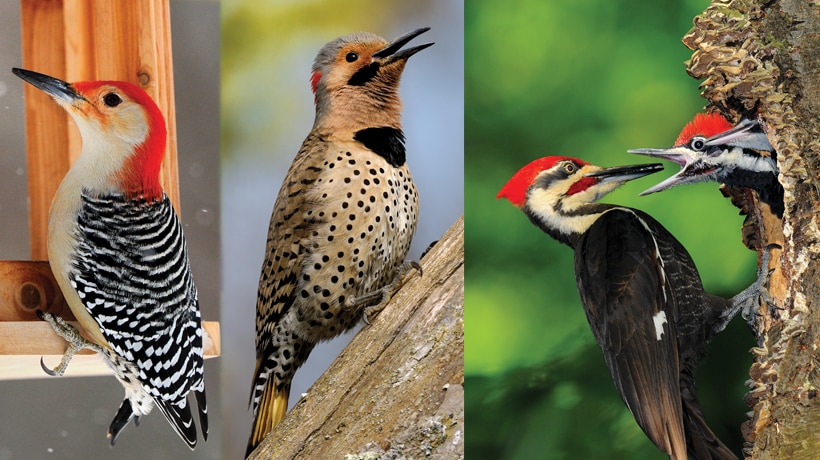Woodpeckers in Florida Populace: Variety Overview and Conservation
Woodpeckers in Florida Populace: Variety Overview and Conservation
Blog Article
Revealing the Tricks of Woodpeckers: Actions, Habitat, and Much More
Woodpeckers, with their distinct behaviors and specialized adaptations, have lengthy interested researchers and nature lovers alike. By discovering the mysteries surrounding woodpeckers' actions and environment options, a deeper understanding of these bird marvels emerges, providing a glimpse right into their interesting world.
Woodpecker Behavior Insights
In examining woodpecker actions, an interesting screen of specialized skills and adjustments emerges, clarifying their impressive eco-friendly specific niche - Woodpeckers in Florida. Woodpeckers, recognized for their distinct drumming on trees, possess a variety of behavior characteristics that contribute to their survival and success in their setting. One essential behavior is their drumming, which offers multiple objectives such as interaction, establishing area, attracting friends, and finding food resources. This balanced pecking also showcases their exceptional strength and endurance, as they can hammer away continually at broadband without creating damage to themselves.
Additionally, woodpeckers show a distinct feeding actions characterized by their capability to remove insects from tree bark using their specialized beaks. Their lengthy, barbed tongues help in capturing victim, while their solid neck muscles provide stability and accuracy throughout pecking motions. This feeding method permits woodpeckers to gain access to surprise insect larvae and extract them with exceptional performance.
Habitat Preferences and Selection
What aspects affect the habitat preferences and selection of woodpeckers? One essential factor influencing woodpecker environment option is the schedule of ideal nesting websites. Woodpeckers normally like woodlands with a mix of mature trees that provide ample possibilities for dental caries excavation.
Furthermore, woodpeckers show a preference for environments with a bountiful supply of food sources. They are largely insectivorous, eating beetles, ants, larvae, and other pests discovered in rotting timber or tree bark. Woodpeckers have a tendency to favor woody areas with a diverse insect populace to satisfy their nutritional requirements.
Additionally, the existence of dead or decaying trees is an additional essential consider woodpecker environment choice. These trees not just supply food sources yet also supply appropriate substrate for cavity excavation. Dead trees are essential for the upkeep of healthy woodpecker populaces, as they play a vital duty in the woodpeckers' life cycle and ecological community dynamics.
Feeding Behaviors and Diet Plan Make-up
Woodpeckers demonstrate a specialized feeding actions concentrated on foraging for bugs within various environments. Their diet regimen mainly is composed of insects such as beetles, ants, caterpillars, and crawlers, which they locate by tapping on tree bark and paying attention for the sound of motion inside. Woodpeckers utilize their strong beaks to drill right into the timber and their long, barbed tongues to draw out target from crevices. Along with pests, woodpeckers also take in tree sap, fruits, nuts, and seeds, including variety to their diet plan relying on the season and accessibility of food sources.
The foraging strategies of woodpeckers are well-adapted to their arboreal way of living. Woodpeckers play a vital function in maintaining the wellness of woodlands by managing insect populations and assisting in the decay of wood.
Drumming Appears and Communication
Using quick drumming noises on various surface areas, woodpeckers employ a distinctive kind of communication to signify area boundaries and bring in companions. This drumming behavior is not just a way browse this site of communication yet likewise serves as a method for woodpeckers to establish their visibility within a particular location. The intensity, rate, and pattern of the drumming can communicate vital info to other woodpeckers in the location.
Woodpeckers utilize drumming audios to reveal their visibility in an area and to advise off prospective burglars. The loud and repeated nature of the drumming works as a clear signal to other woodpeckers that the location is currently declared. This aids in reducing problems and reducing physical fights between individuals.

Survival Adaptations and Specialized Anatomy

Final Thought
Finally, woodpeckers exhibit unique actions, such as drumming noises for communication, and have actually specialized composition for survival in their chosen environments. Their feeding practices and diet composition additionally demonstrate their versatility to numerous environments. By recognizing these facets of woodpeckers, researchers and preservationists can much better safeguard and maintain these interesting birds and their communities.
Report this page